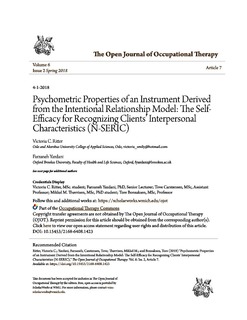| dc.contributor.author | Ritter, Victoria C. | |
| dc.contributor.author | Yazdani, Farzaneh | |
| dc.contributor.author | Carstensen, Tove | |
| dc.contributor.author | Thørrisen, Mikkel Magnus | |
| dc.contributor.author | Bonsaksen, Tore | |
| dc.date.accessioned | 2018-04-05T11:10:39Z | |
| dc.date.available | 2018-04-05T11:10:39Z | |
| dc.date.created | 2017-06-28T21:26:57Z | |
| dc.date.issued | 2018 | |
| dc.identifier.citation | The Open Journal of Occupational Therapy. 2018, 6 (2), 1-8. | nb_NO |
| dc.identifier.issn | 2168-6408 | |
| dc.identifier.uri | http://hdl.handle.net/11250/2492807 | |
| dc.description.abstract | Background: The Intentional Relationship Model conceptualizes the therapeutic use of self in occupational therapy. To increase motivation for and success in establishing therapeutic relationships, therapists need self-efficacy for using the self in therapeutic practice. However, attempts to combine this model with self-efficacy theory are rare, and instruments by which to measure self-efficacy for therapeutic use of self are in a developing stage. This study aimed to examine the factor structure and internal consistency of the Norwegian Self-Efficacy for Recognizing Interpersonal Characteristics (N-SERIC).
Methods: Occupational therapy students (n = 100) from two education programs completed the instrument and sociodemographic information. The factor structure was examined with Principal Components Analysis (PCA), and internal consistency was assessed with Cronbach’s α and inter-item correlations.
Results: The PCA revealed that all N-SERIC items belonged to the same latent factor, with factor loadings ranging between 0.75 and 0.89. The internal consistency of the scale items was high (Cronbach’s α = 0.96).
Conclusions: The N-SERIC scale is unidimensional and the items have very high internal consistency. Thus, the scale sum score can be useful for occupational therapy research and audits focusing on interpersonal aspects of practice. | nb_NO |
| dc.language.iso | eng | nb_NO |
| dc.publisher | Western Michigan University | nb_NO |
| dc.rights | Attribution-NonCommercial-NoDerivatives 4.0 Internasjonal | * |
| dc.rights.uri | http://creativecommons.org/licenses/by-nc-nd/4.0/deed.no | * |
| dc.title | Psychometric Properties of an Instrument Derived from the Intentional Relationship Model: the Self-Efficacy for Recognizing Clients’ Interpersonal Characteristics (N-SERIC) | nb_NO |
| dc.type | Journal article | nb_NO |
| dc.type | Peer reviewed | nb_NO |
| dc.description.version | publishedVersion | nb_NO |
| dc.source.pagenumber | 1-8 | nb_NO |
| dc.source.volume | 6 | nb_NO |
| dc.source.journal | The Open Journal of Occupational Therapy | nb_NO |
| dc.source.issue | 2 | nb_NO |
| dc.identifier.doi | 10.15453/2168-6408.1423 | |
| dc.identifier.cristin | 1479684 | |
| dc.description.localcode | © 2018 The Authors. Published by Western Michigan University. This work is licensed under a Creative Commons Attribution-NonCommercial-NoDerivatives 4.0 International License. | nb_NO |
| cristin.unitcode | 194,65,30,0 | |
| cristin.unitname | Institutt for nevromedisin og bevegelsesvitenskap | |
| cristin.ispublished | true | |
| cristin.fulltext | original | |
| cristin.qualitycode | 1 | |

